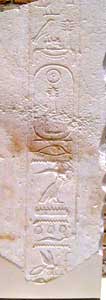
Djedkare (“the soul of Re endureth”) Isesi ruled ancient Egypt during the fifth dynasty (Old Kingdom). He may have been the son of his predecessor Menkauhor, but there is no positive evidence of this, and it is also proposed by some that he was the son of Niuserre.
According to the Turin Canon Djedkare ruled for 28 years (although this is sometimes read as 38 years). Manetho records 44 years for this king. However, the mummy currently thought to be Djedkare suggests he was about 50 when he died. He may have been married to Meresankh IV who was buried in the main necropolis in Saqqara, but it is also possible that Meresankh was the wife of Menkauhor. Another unnamed queen was interred alongside Djedkare in the southern necropolis. Reworkings of some of the text in this tomb and elements of the structure which would normally be associated with the tomb of a king have led some to suggest that this queen may have ruled for a time after his death. Unfortunately, her tomb is badly damaged and the excavation results have not been fully published, so positive confirmation of this has not been recovered.

Djedkare was the father (or brother) of Prince Isesi-ankh (who was buried in Saqqara) and the father of Prince Neserkauhor, Princesses Kekheretnebti, Meret-Isesi, Hedjetnebu, and Nebtyemneferes (who were all buried in Abusir). It is also possible that he was the father of Prince Raemka and Prince Kaemtjenent (although they may instead have been the children of Menkauhor) and Princess Kentkhaus (the wife of the Vizier Senedjemib Mehi). He was probably also the father of Unas. Although there is no positive evidence for this family connection, the smooth transfer of power between the two kings and the frequency of references to officials who had names including “Isesi” on the causeway of Unas are cited as support.

Djedkare recorded two expeditions to the Sinai, and his name was found in the quarries in Aswan, Abydos and Nubia. Graffiti in Nubia refers to an expedition to Punt and he seems to have had good diplomatic and trading relations with Byblos.
During his reign, the importance of the solar cult seems to have waned. He was the first king of his dynasty not to build a sun temple, and he built his tomb at Saqqara rather than Abusir. The only image of the king is from a temple to Osiris, whose increasing importance becomes obvious in the Pyramid Texts of his successor, Unas. Central government was cut back and local administration improved. In particular, he reorganised the roles and titles of priests and officials. He is the king named in the Instructions of Ptahhotep (also known as the Maxims of Ptahhotep) which recounted the ideal qualities of a successful official in ancient Egypt so it is proposed that they were written by his Vizier, although Lichtheim suggests that they were in fact composed towards the end of the sixth dynasty.
Even though the Pharaoh returned to the traditional burial ground at Saqqara, he continued to maintain the funerary temples in Abusir. His pyramid is now little more than rubble, but an inscription found inside it proved that he was the original owner (the tomb had been reused in the Eighteenth Dynasty).
Pharaoh’s Names
- Manetho; Tencheres
- Horus name: Djed-khau
- Nebty name: Djed-khaw-Nebty
- Golden Falcon name: Bik-nub-djed
- Prenomen: Djedkare
- Nomen: Isesi
Bibliography
- Aidan Dodson and Dyan Hilton (2004) The complete royal families of Ancient Egypt
- Peter A Clayton (1994) Chronicle of the Pharaohs
- Jaromir Malek (2003) “The Old Kingdom” in Oxford History of Ancient Egypt. Edited by I Shaw
- M. Lichtheim (2006) Ancient Egyptian Literature, Volume I
- Verner, Miroslav (2001) The Pyramids
- Wilkinson, Toby (2010) The Rise and Fall of Ancient Egypt
Copyright J Hill 2010